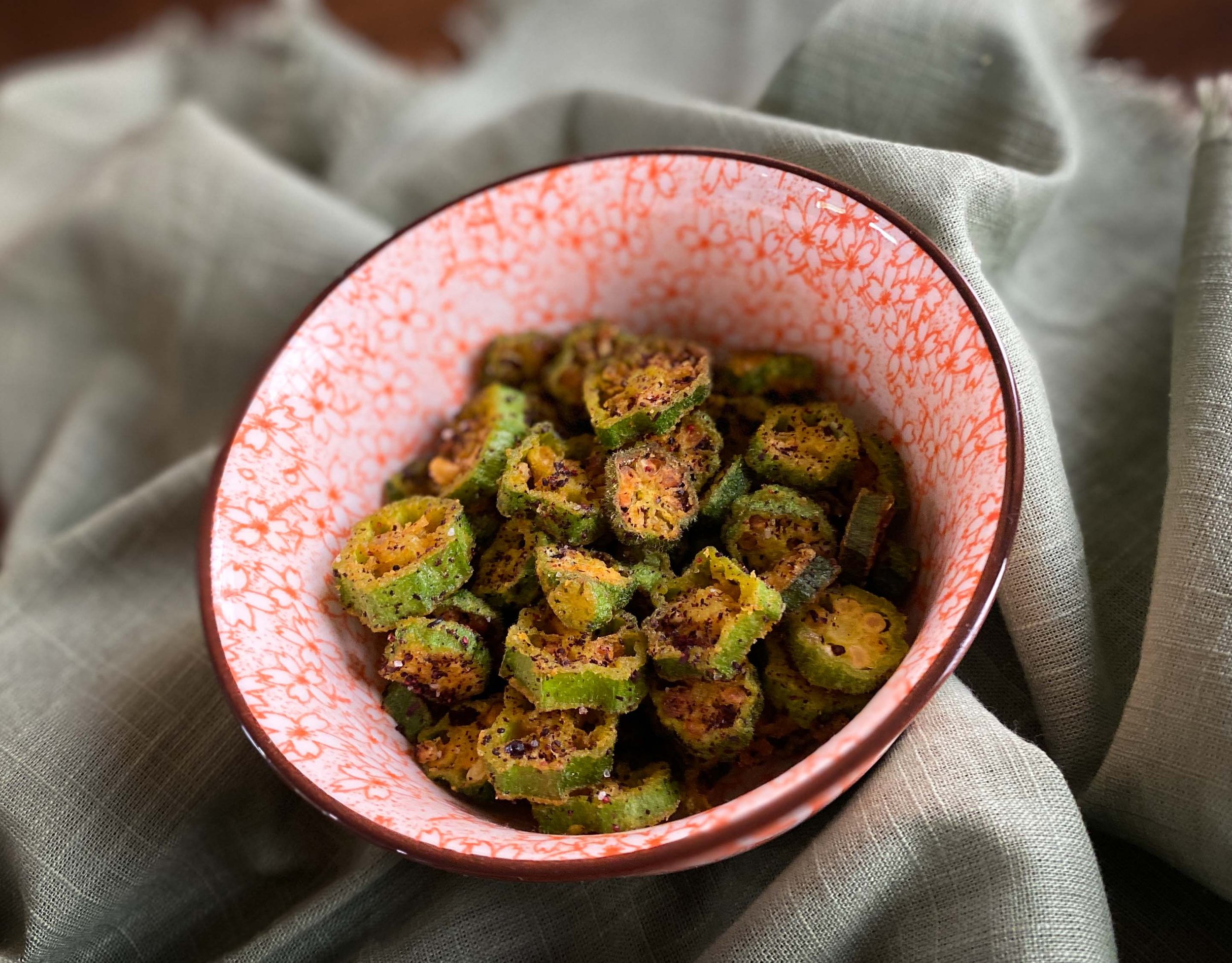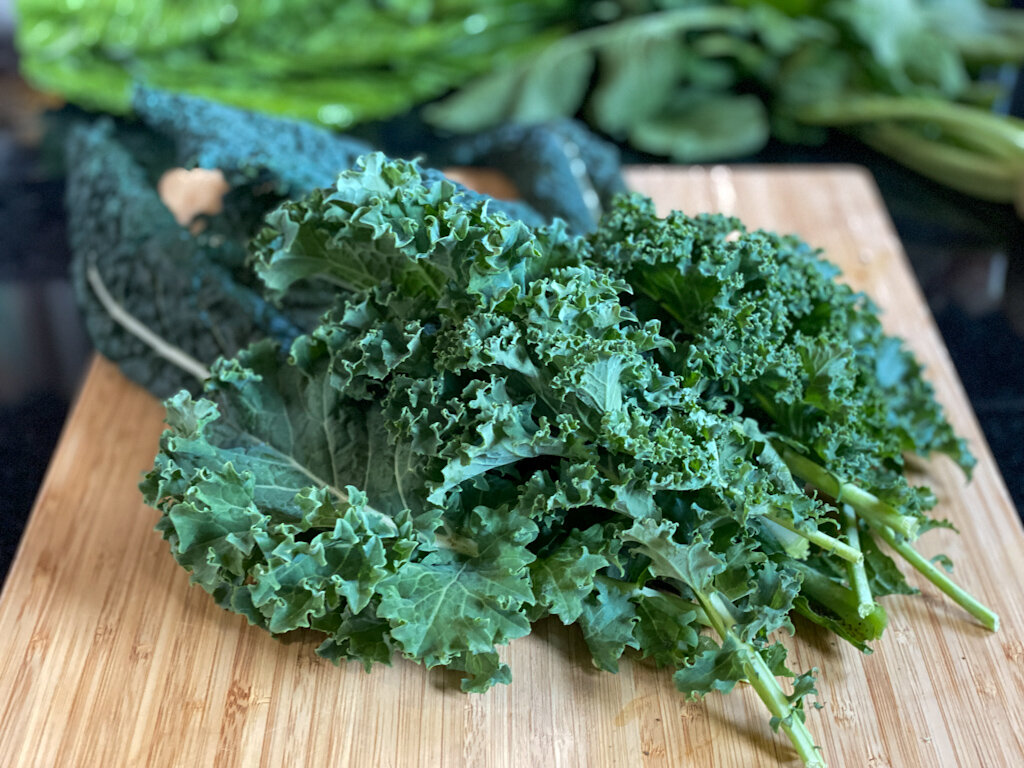Quiabos Tostados com Pimenta — Brazililan Chargrilled Okra with Chile
By Leslie Brenner
Simmer it in a savory gumbo. Capture it in a pickle. Roast it to show off its depth. It’s the height of okra season, and there are endless delicious ways to treat the fascinating, polarizing pod.
You can shallow-fry it as Indian-spiced rounds that highlight its captivating geometry. Halve it lengthwise and grill it to smoky goodness. Cook it with tomatoes and onions, stir in olive oil and herbs and serve it as a tangy, cool Levantine salad.
Food historians disagree about okra’s origins. Most, including Jessica B. Harris (author of The Africa Cookbook: Tastes of a Continent), pin it as Africa. “The mucilaginous pod is the continent’s culinary totem,” she writes. “From the bamia of Egypt to the soupikandia of Senegal, passing by the various sauces gombos and more, this pod is used in virtual continent-wide totality.” Others say it comes from South Asia or Southeast Asia.
What’s indisputable is that okra has long since become a citizen of the world.
In Asia, it appears in various guides from India to Vietnam to Japan. A sour fish soup from Vietnam, canh chua cá, features okra, tamarind and pineapple. The late Shizuo Tsuji gave a recipe for okura wasabi-jōyu — a simple okra salad with wasabi, soy sauce and mirin — in his landmark 1980 book Japanese Cooking: A Simple Art. And in India, okra is popular quick-fried till crispy.
Crispy Sumac Okra from Anjali Pathak’s ‘The Indian Family Kitchen’
Intrigued? Try this crunchy, addictive version of Crispy Sumac Okra, adapted from Anjali Pathak’s The Indian Family Kitchen.
In Africa, Egypt has bamia (okra made sweet and sour with honey and lemon); Ethiopia has bamya alich’a (okra simmered with tomatoes, onions, garlic and spices); Benin has sauce bombo (okra simmered with tomatoes and chile, served on rice); and Nigeria has akara awon (bean-and-okra fritters). Recipes for all four, and more, can be found in Harris’ The Africa Cookbook.
Out of Africa, okra dishes appear all over the Levant, and in Afghanistan, Armenia and Kurdistan. In Turkey, okra are dried and later made into a soup, banya corbasi. Lebanon is home to a lamb and okra stew called bamya bel lameh, and also a delightful braised okra and tomato dish served cool or room temp, as part of a mezze — bamieh bi zeit. Glossy with olive oil, it’s particularly nice this time of year, as tomatoes and okra are both in high season. Claudia Roden offers a wonderful version in her classic 2006 book Arabesque: A Taste of Morocco, Turkey and Lebanon. Our adaptation takes her up on her suggested variation of using tangy pomegranate vinegar in place of sugar in the recipe.
Bamieh Bi Zeit — Lebanese Okra and Tomato, served cold as a salad
And then there are all the African diasporic dishes. These are the okra dishes that, over the centuries, have become extraordinarily meaningful for the communities descended from enslaved people, from South America to the Caribbean to the United States.
In the American South, okra appears in gumbos and other soups and stews — often with tomatoes (as in Lebanon and all over the Levant) and/or shrimp. BJ Dennis, a Charleston, South Carolina chef with roots in the low country Gullah-Geechee community, has a magnificent recipe for Okra & Shrimp Purloo in Black Food: Stories, Art, and Recipes from Across the African Diaspora, edited and curated by Bryant Terry and published last year. From Dennis’ headnote:
“Okra is a vegetable that is dear to many of us throughout the African diaspora. And of course there’s shrimp, which is vital to our culture. This is a dish of pain, resilience and celebration. It’s the story of our existence in the so-called New World. If you were to give me one final meal to eat, it would be this.”
BJ Dennis’ Purloo with Okra & Shrimp, from ‘Black Food,’ edited and curated by Bryant Terry
Recently Dennis helped the International African American Museum (slated to open in January 2023) develop a Gullah-inspired menu; the cafe, Dennis tells me, expected to open the following year. Meanwhile, here’s our adaptation of his marvelous recipe, which also features Carolina Gold rice, another low country food with deep meaning for Gullah-Geechee’s descendants of enslaved people.
Okra pods go by the name molondrones in the Dominican Republic, where they’re eaten as a stew (guisado de molondrones) or salad. Guisados starring okra are also popular in Cuba and Puerto Rico, where the vegetable is called quimbombó.
From Brazil comes salada da quiabo, an okra salad, and caruru — a shrimp and okra stew. The state of Bahia is known for the dish; in Pará — the country’s northernmost state — caruru is a shrimp and okra curry. There’s a delicious-looking recipe for it in Thiago Castanho’s 2014 book Brazilian Food. “The origins of caruru point to a divided authorship between native Indians and Africans,” writes Castanho in the headnote. “This typical dish of Bahia state is nowadays associated with the African-Brazilian religious ritual, Candomblé, and served as a main course, as here, or as part of a banquet.”
I haven’t yet cooked or tasted a traditional caruru, but I recently had the pleasure of tasting a fabulous spin at Meridian, a spectacular modern Brazilian restaurant in Dallas (which happens to be a client of my consulting business).
Grilled Jumbo Prawn Caruru from Meridian, a modern Brazilian restaurant in Dallas, Texas
In his Grilled Jumbo Prawn Caruru, Meridian’s executive chef, Junior Borges — who is from Brazil, near Rio de Janeiro — featured okra all kinds of ways: braised in the sauce, halved lengthwise and charred to top, raw as little round okra exclamation points. It was an okra tour de force — served with a Carolina Gold rice cake that’s deep-fried and dusted with ramp powder.
Chef Borges told me, when he featured the dish recently, that caruru has “deep meaning” for him and his family.
Much simpler than either chef Borges’ or Castanho’s caruru — and unlike those, a snap to prepare at home — is Quiabos Tostados com Pimenta (chargrilled okra with chile). Our adaptation is also from Castanho’s Brazilian Food. To make it, drizzle whole okra pods with olive oil, char them on a grill-pan, season them with aviú (tiny Brazilian dried salted shrimp) or other dried salt shrimp, plus thinly sliced fresh red chiles, lime juice and cilantro.
It’s absolutely transporting. And I love chef Castanho’s suggestion that if you can’t find aviú or other dried shrimp, you can use katsuobushi — Japanese bonito flakes — instead. The katsuobushi adds a similar aquatic umami note, while incontrovertibly proving that okra is, by any measure, a well traveled, adaptable, flexible, deliciously versatile citizen of the world.
Did you enjoy this story? You might also like:
MORE OKRA RECIPES from Cooks Without Borders:
RECIPE: Shrimp Sauté with Texas Vegetables
RECIPE: Marcus Samuelsson’s Spicy Okra
RECIPE: Charred Okra with a Little Spice


















